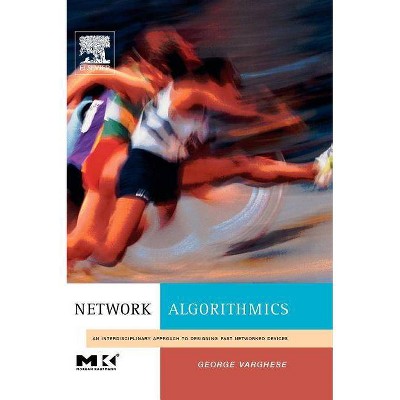Top-Down Network Design - (Networking Technology) 3rd Edition by Priscilla Oppenheimer (Hardcover)

Similar Products
Products of same category from the store
AllProduct info
<p/><br></br><p><b> About the Book </b></p></br></br><p><b>Top-Down Network Design, 3rd Edition</b> presents a systematic, fully practical approach to designing networks.</p> <p>Thoroughly updated for today's newest technical and business trends, it covers all facets of enterprise network design and all elements of modern enterprise networks. The authors' innovative top-down approach starts by focusing on applications and user requirements, and only then turns to technology selection. Readers will discover how to systematically analyse business and technical requirements, and then select topologies and technologies that reflect this analysis. The authors walk through designing campus networks, data centers, remote access, and wide-area connectivity, and designing for security in an era of wireless networks and mobile users. They also present detailed coverage of performance, reliability, and scalability. </p> <p>This edition includes new coverage of designing networks that comply with IT Service Management processes, as well as an updated glossary. It also adds chapter-ending essay questions and design scenarios for readers who want to test their understanding of key concepts. </p><p/><br></br><p><b> Book Synopsis </b></p></br></br><b>Objectives</b></p> The purpose of Top-Down Network Design, Third Edition, is to help you design networks that meet a customer's business and technical goals. Whether your customer is another department within your own company or an external client, this book provides you with tested processes and tools to help you understand traffic flow, protocol behavior, and internetworking technologies. After completing this book, you will be equipped to design enterprise networks that meet a customer's requirements for functionality, capacity, performance, availability, scalability, affordability, security, and manageability.</p> </p> <b>Audience</b></p> This book is for you if you are an internetworking professional responsible for designing and maintaining medium- to large-sized enterprise networks. If you are a network engineer, architect, or technician who has a working knowledge of network protocols and technologies, this book will provide you with practical advice on applying your knowledge to internetwork design.</p> </p> This book also includes useful information for consultants, systems engineers, and sales engineers who design corporate networks for clients. In the fast-paced presales environment of many systems engineers, it often is difficult to slow down and insist on a top-down, structured systems analysis approach. Wherever possible, this book includes shortcuts and assumptions that can be made to speed up the network design process.</p> </p> Finally, this book is useful for undergraduate and graduate students in computer science and information technology disciplines. Students who have taken one or two courses in networking theory will find Top-Down Network Design, Third Edition, an approachable introduction to the engineering and business issues related to developing real-world networks that solve typical business problems.</p> </p> <b>Changes for the Third Edition</b></p> Networks have changed in many ways since the second edition was published. Many legacy technologies have disappeared and are no longer covered in the book. In addition, modern networks have become multifaceted, providing support for numerous bandwidth-hungry applications and a variety of devices, ranging from smart phones to tablet PCs to high-end servers. Modern users expect the network to be available all the time, from any device, and to let them securely collaborate with coworkers, friends, and family. Networks today support voice, video, high-definition TV, desktop sharing, virtual meetings, online training, virtual reality, and applications that we can't even imagine that brilliant college students are busily creating in their dorm rooms.</p> </p> As applications rapidly change and put more demand on networks, the need to teach a systematic approach to network design is even more important than ever. With that need in mind, the third edition has been retooled to make it an ideal textbook for college students. The third edition features review questions and design scenarios at the end of each chapter to help students learn top-down network design.</p> </p> To address new demands on modern networks, the third edition of Top-Down Network Design also has updated material on the following topics: </p> ¿ Network redundancy</p> ¿ Modularity in network designs</p> ¿ The Cisco SAFE security reference architecture</p> ¿ The Rapid Spanning Tree Protocol (RSTP)</p> ¿ Internet Protocol version 6 (IPv6)</p> ¿ Ethernet scalability options, including 10-Gbps Ethernet and Metro Ethernet</p> ¿ Network design and management tools</p> </p><p/><br></br><p><b> From the Back Cover </b></p></br></br><p>Top-Down Network Design</p> <p>Third Edition</p> <p> </p> <p>Priscilla Oppenheimer</p> <p> </p> <p>A systems analysis approach to enterprise network design</p> <p> </p> <p>The authoritative book on designing networks that align with business goals</p> <p><i> </i></p> <p><i>Top-Down Network Design</i>, Third Edition, is a practical and comprehensive guide to designing enterprise networks that are reliable, secure, and scalable. The book uses a top-down approach to help you focus first on applications and user requirements before selecting devices, cabling, and other technologies to implement the network. The book takes you through an explanation of how to design networks that align with business goals so that the network can keep pace with changing user requirements. </p> <p> </p> <p>This new edition provides a comprehensive look at enterprise network design and the different modules of an enterprise network. Using illustrations and real-world examples, the book covers campus network design, wireless networks, remote access, and wide-area connectivity. You learn how to analyze business and technical requirements and select topologies and technologies that are based on that analysis. A major focus is on security as network users become more mobile. You also develop an understanding of network performance factors and methods for building reliable networks that can scale as traffic loads increase. </p> <p> </p> <p>This Third Edition includes updated and expanded material on wireless networks, virtual private networks (VPN), network security, network redundancy, modularity in network designs, dynamic addressing for IPv4 and IPv6, Ethernet scalability options (including 10-Gbps Ethernet, Metro Ethernet, and Long-Reach Ethernet), and networks that carry voice and data traffic. In addition you will learn how to build networks that can support real-time video, collaborative computing, and social networking tools and that adhere to the Cisco SAFE Security Reference Architecture.</p> <p> </p> <p>Every chapter now includes a set of essay questions and design scenarios to give you a chance to practice what you have learned. The book also has a companion website at www.topdownbook.com, which includes updates to the book, links to white papers, and supplemental information about design resources.</p> <p> </p> <ul> <li>Learn a network design process that results in networks that perform well, provide security, and scale to meet growing demands for bandwidth </li> <li>Develop network designs that provide the high bandwidth and low delay required for real-time applications such as multimedia, distance learning, videoconferencing, teleprescene, virtual communities, and IP telephony </li> <li>Master techniques for checking the health of an existing network to develop a baseline for measuring performance of a new network design </li> <li>Explore solutions for meeting QoS requirements, including IETF controlled-load and guaranteed services, IP multicast, and advanced switching, queuing, and routing algorithms </li> <li>Identify the advantages and disadvantages of various switching and routing protocols, including Rapid Spanning Tree Protocol (RSTP), IEEE 802.1Q, EIGRP, OSPF, and BGP4</li> </ul> <p> </p> <p><i>This book is part of the Networking Technology Series from Cisco Press' which offers networking professionals valuable information for constructing efficient networks, understanding new technologies, and building successful careers.</i></p> <p> </p> <p>Category: Networking</p> <p>Covers: Network Design</p> <p> </p><p/><br></br><p><b> About the Author </b></p></br></br><b>Priscilla Oppenheimer</b> has been developing data communications and networking systems since 1980 when she earned her master's degree in information science from the University of Michigan. After many years as a software developer, she became a technical instructor and training developer and has taught more than 3000 network engineers from most of the Fortune 500 companies. Her employment at such companies as Apple Computer, Network General, and Cisco gave her a chance to troubleshoot real-world network design problems and the opportunity to develop a practical methodology for enterprise network design. Priscilla was one of the developers of the Cisco Internetwork Design course and the creator of the Designing Cisco Networks course. Priscilla teaches network design, configuration, and troubleshooting around the world and practices what she preaches in her network consulting business.</p>
Price History
Price Archive shows prices from various stores, lets you see history and find the cheapest. There is no actual sale on the website. For all support, inquiry and suggestion messagescommunication@pricearchive.us




















